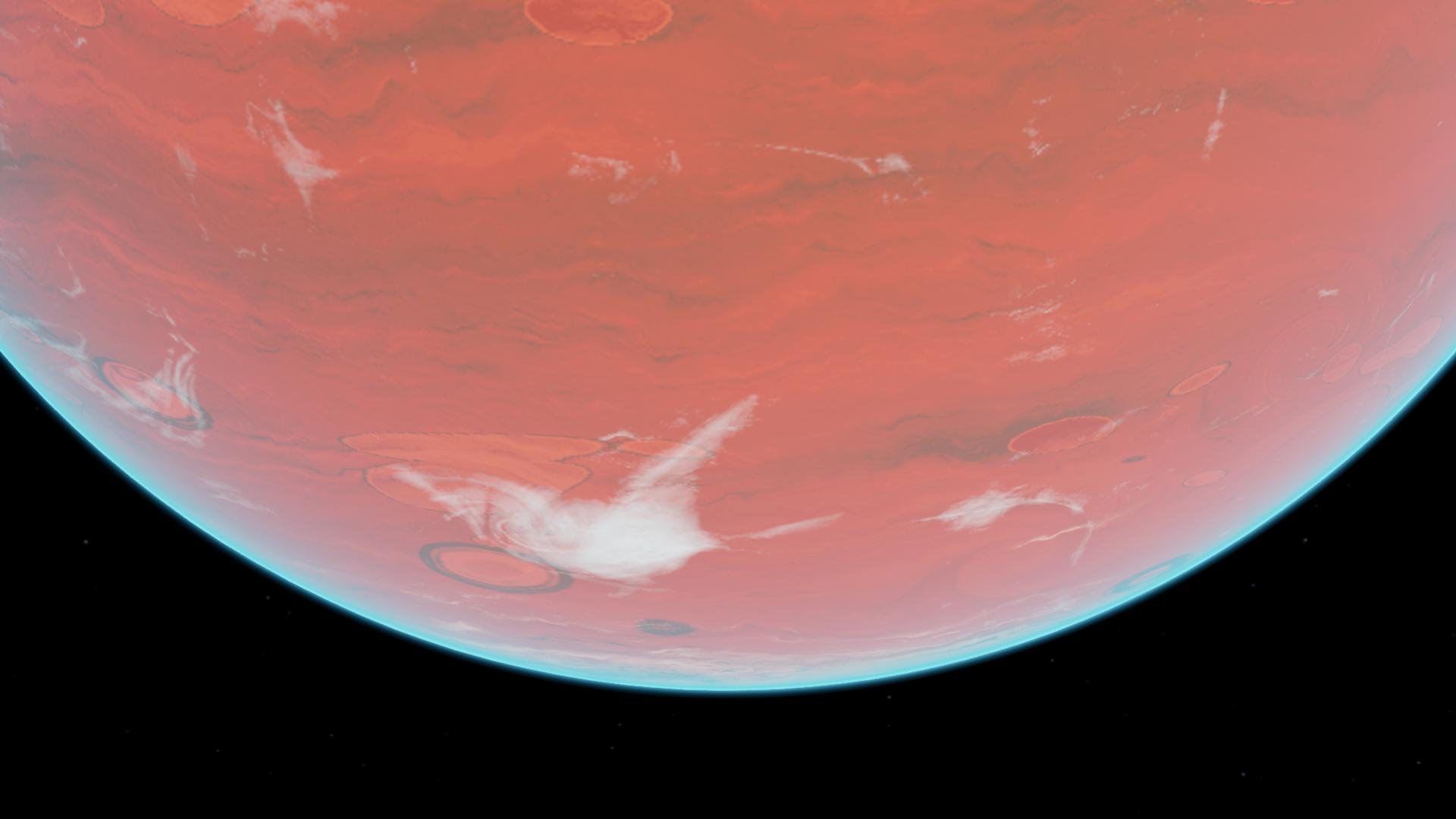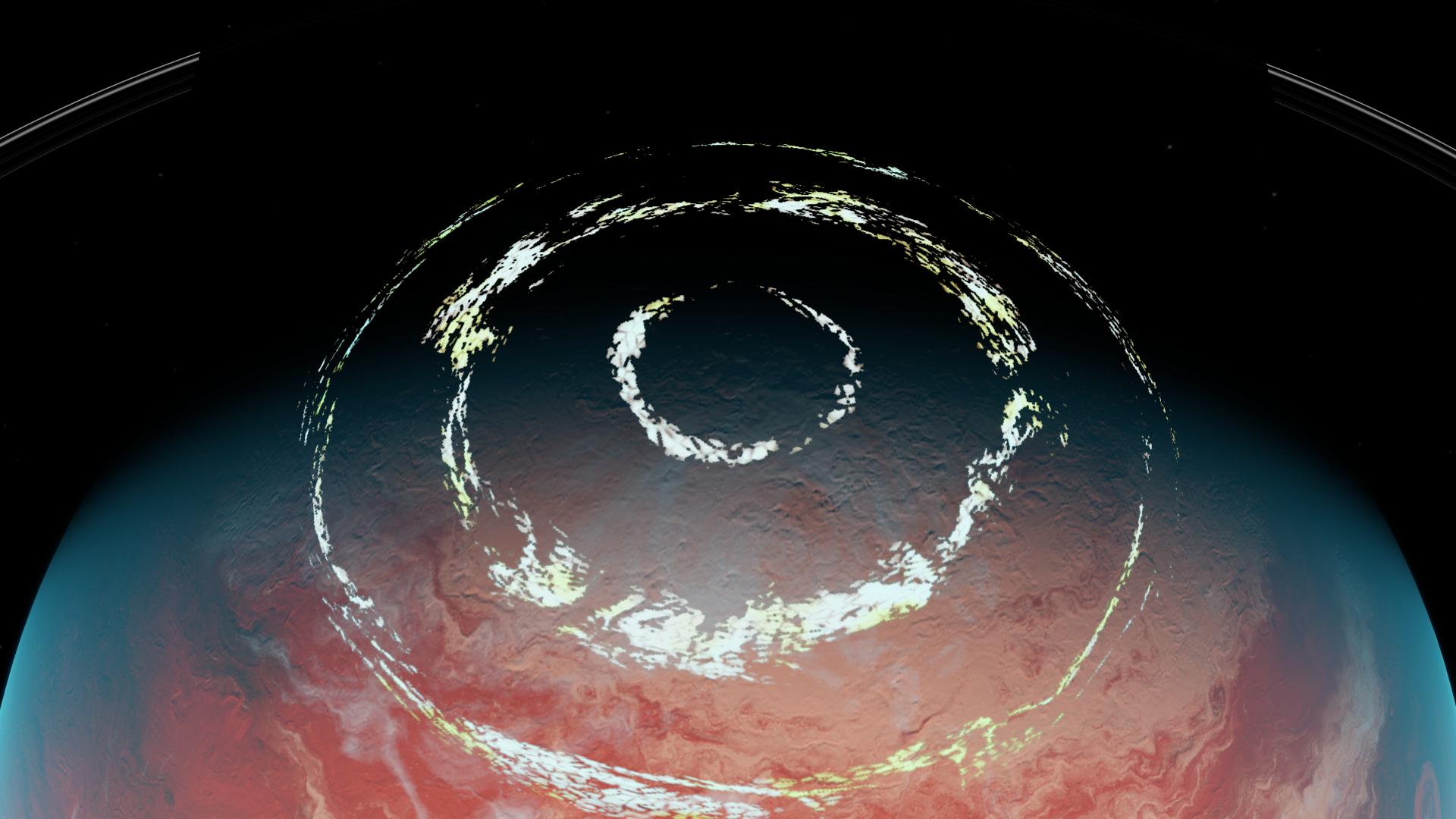
Other Name(s): Andrellis, Adam, Adath
Pronunciation: An - dree - os
"Firmament of pandemonium"
again, the US2 version was dull, had no rings, and was just outright boring

from the Universe Sandbox 2 variant of Antarius System
inspiration: Wasp-19b

Class:
Warm Jovian
General Characteristics:
Jovian Masses: 1.44 mj
Jovian Radius: 1.42 rj
Density per cubic centimeter: 0.671 g/cm^3
Avergage Temperature: ~463.18k
Surface Gravity: 18.6m/s^2
Age: ~5.392 SBY
Atmospheric Characteristics:
Surface Atmospheric Composition:
38.65% Nitrogen
17.47% Ammonia
14.71% Nitrogen Dioxide
9.84% Oxygen
6.81% Phosphine
4.89% Water Vapour
2.57% Carbon Dioxide
0.79% Trace Gases
Atmosphere Pressure: 2.461 atm
Atmospheric Mass: 2.526 aE
Atmospheric Density: 2.897 kg/m^3
[Note]: This is from "breathable" altitudes. The atmospheric parameters change the higher or lower you go]
Orbital Characteristics:
Orbital Parent(s): Arventhor, Tempris
Orbital Period: 3.1002 SY
Semi Major Axis: 3.081 au
Orbital Eccentricity: 0.00135
Orbital Inclination: 0.000632°
Rotational Period: 0.488 SD
Obliquity: 8.12°
4th Planet from Arventhor. Lies in between the orbits of Kalabann and Targus.
Andrios, also known as Antarius IV (called “Anderoth” by the natives”), is a gas giant that's moderately larger than Jupiter while boasting a low density of its size. This led to a considerably lower gravity, much lower than that of Jupiter. However, this is contradictory, as most gas giants in the Antarius System—let alone the entire Tanis Nebula—are high in mass, resulting in a higher gravity than average. Aside from its strange composition, its bands and atmosphere are quite turbulent. Andrios has very extravagant bands, with swirling storms all over the planet. There are also clouds of water vapor, contrasting the color of the bands. Its auroras, generated by its relatively weaker magnetosphere (compared to other gas giants), have one of the strangest patterns ever discovered so far.
Planet Lore
Andrios is the 4th planet from Antarius, and the 4th largest planet in the Antarius System, beyond the size Katharaeas, but smaller than Tarsaeas. Andrios boasts a small, thing, and a faint ring system composed of rocks and some metals. It is also known for its considerably large moon system, roughly similar to that of Tarsaeas' or Ondriall's. Andrios' fame stems from its never-ending storms, turbulent atmosphere, and contrasting colors. Its bands are a blood-red hue, thanks to the excessive amount of ammonia compounds. There is no organic life on Andrios, not even exotic microorganisms, or extremophiles.
The planet is home to strange floating structures with colors of black and red. Upon further inspection, we can see that these peculiar large objects orbit a bigger structure. This was one of the places fought during the Aurean Great War. A Hyperant, Vanossias, was one of the most powerful. This Hyperant also had no good intentions either, as it rebelled against the Aureus Civilization and the other Hyperants, in an attempt to destroy and control the Aureus and the Hyperants. He was doing well at first, employing tactics and using his powers to subdue the Hyperants, using nanobots. He and the most powerful Hyperant, Zolphyus Kaith, fought each other hard. Eventually, Vanossias was defeated, retreated here, and was contained for a very long time.
He is essentially a viral AI, with very evil intentions. He is very egotistical, with an ego the size of the whole universe. His true origin is also unknown (but so is the same for every other Hyperant). Speaking about his powers, he uses a lot of nanotechnology, mainly through the use of self-replicating nanobots. He can control these bots with ease, able to create swarms and soldiers with them. The said nanobots can outright devour victims, or bite them and “infect” them. They will spread from the bite and replicate until it consumes them entirely. Vanossias can also change his appearance. He takes a large interest in bipedal creatures, mainly the Terrans and the Alluteans. He can also mimic machinery, though this works best if he has sufficient knowledge about it. We are safe for now, but it seems that it is evident that this seal will not last for a few more years…
Andrios has a moon system very similar to that of Tarsaeas, just a few moons less. The closest moon, Metteron, is warm and has a sulfur-based atmosphere, with some oxygen, nitrogen, and ammonia. Metteron gets most of its ammonia from Andrios, mainly during the formation of the planet. Although most of the other moons are quite barren, either having a thin atmosphere or none at all, each of them shares something unique (like most of the celestial bodies in the Antarius). Andrios is also home to, you guessed it, no life! Although it may seem like it does, mainly because the ammonia looks like tholins. There was life in the far past, but it soon died out for unknown causes. The currently accepted theory is that there was a spike in ammonia and that Andrios was much more orange in the past. When life on Andrios formed through Abiogenesis, it releases ammonia as a byproduct from something. The current idea of what it ate or got energy and released ammonia as a byproduct is currently null, though we can only guess. Since then, ammonia levels have increased by a lot and have since killed the lifeforms. Andrios is such a red beauty, with its contrasting clouds and atmosphere, to the staggering auroras with complex patterns that bless eye.
Natural Satellites:
Metteron
Yiran
Yukkax
Liumm
Ballos
Norrienth
Depreclite
Cogarath
Zephus
Linulia
Alenov
Total Amount of Natural Satellites::
| Major: 11 | Minor: 78 |
Creator's Remarks: "This planet probably has the most unique aurora I ever made. I like the integration of cellular noise in auroras. It adds well to the 'turbulence'." Anyways...
CHANGELOG:
- Added Rings
- Added Auroras
- Added Clouds
- Revamped Atmosphere
- Revamped Lighting
- Shuffled Bands
- Overhauled Polar Bands
- Shuffled Storm Generation
- Added Crush Altitude
GENERAL INFO
- Predecessor: Andrios [LEGACY]
- Created On: Windows
- Game Version: 1.3.201.0
CHARACTERISTICS
- Radius: 99,066 km
- Sea Level: None
- Surface Gravity: 18.6 m/s
- Rotational Period: N/A
- Escape Velocity: 60.71 km/s
- Mass: 2.74E+27kg
Atmosphere
- Height: 2,600 km
- Scale Height: 376 km
- Surface Air Density: 2.897 kg/m3
- Surface Temperature: 463 K
EQUIRECTANGULAR MAP

13 Comments
- Log in to leave a comment
-
10.9k deepfriedfrenchtoast+1 4 months ago
@Tallisar Hell yeah. I actually like having these critical discussions in the comments if im being honest, so its not a problem for me if they go on and on, I mean if I didnt like participating in them then I would keep my mouth shut.
-
16.1k Tallisar4 months ago
Now that I look back, I just decided to change it lol. Sorry @deepfriedfrenchtoast for taking millions of years, but I did forget about this lol (Your Welcome).
-
-
16.1k Tallisar5 months ago
I'll just leave it as is for heck's sake @deepfriedfrenchtoast. End of discussion.
-
10.9k deepfriedfrenchtoast5 months ago
@Tallisar this isnt really about the color of the gas giant, its about listing ammonia properly. Just listing all three terms as "Ammonia" in the description would be right since all those terms basically mean ammonia. Im not really sure what gasses could make the gas giant red other than chemicals made from photochemical reactions like tholins, and or some form of phosphorus gas maybe. Possibly something like bromine gas maybe, if you want your gas giant to be deathly toxic and a warcrime.
-
16.1k Tallisar5 months ago
Then what do you want me to do @deepfriedfrenchtoast? I don't know how to make gas giants chemically red! Again, I'm not a chemist, and for the millionth time, IM NOT OPTING FOR REALISM! What are some other gases I can use that can make the planet red?
-
10.9k deepfriedfrenchtoast+1 5 months ago
@Junkthunder Yeah, using the term ammonia is fine. Though its kinda funny to me how the discription lists three ammonia substances, all of which are the same thing.
-
3,919 Junkthunder5 months ago
@deepfriedfrenchtoast just ammonia as a gas is fine. Ammonium hydroxide is a solution of ammonia in water. And as you pointed out anhydrous ammonia is just pure liquid ammonia.
While just ammonia(the gas) does actually float around in atmospheres and is an atmospheric gas.
-
10.9k deepfriedfrenchtoast5 months ago
@Tallisar it's not a specific compound, again it's if you would pour 30 percent ammonia and 70 percent water into a container, you'd have ammonia hydroxide. Anhydrous ammonia being in the atmosphere isnt right too, since the term is usually used to describe bottled liquid ammonia that has a very low amount of water in it.
-
16.1k Tallisar5 months ago
but there is water and ammonia in the atmosphere though? also i just used it from Ondriall @deepfriedfrenchtoast.
-
10.9k deepfriedfrenchtoast5 months ago
Not sure why ammonium hydroxide is one of the atmospheric gasses since it is a mixture of water and liquid ammonia.
-







On top of that @deepfriedfrenchtoast, it teaches me new things too.